Main events of the week
|
The international campaign against ISIS
US and coalition airstrikes
- This week, the US and coalition forces continued their airstrikes against ISIS targets. During the week, dozens of airstrikes were carried out in Syria and Iraq. The airstrikes were carried out using combat aircraft, attack aircraft and unmanned aerial vehicles.
- Following are the main airstrikes (CENTCOM website):
- Syria– the airstrikes were concentrated in the city of Al-Raqqah, which is controlled by ISIS. Sixteen airstrikes were carried out against ISIS strongholds in the city. According to a US Army spokesman, the attacks killed at least ten ISIS operatives and injured several others. Infrastructure and highways held by ISIS were also destroyed. The purpose of the airstrikes was to destroy ISIS’s ability to move troops throughout Syria and Iraq (The Guardian, July 5, 2015). Airstrikes were also carried out in the areas of Al-Hasakah, Kobani and Tell Abyad. The airstrikes reportedly targeted ISIS tactical units, vehicles, buildings, battle positions, bunkers and motorcycles, among other things.
- Iraq– the airstrikes were concentrated in Hawija, Baiji, Fallujah, Haditha, Makhmur, Mosul, Sinjar, Tal Afar, Al-Baghdadi, Al-Qaim, Habbaniyah andKirkuk. The airstrikes reportedly targeted ISIS buildings, weapons, tactical units, vehicles, heavy machinery, bunkers, tunnels and missile systems, among other things.
Statements made by the US president and senior officials
- In a speech given by US President Barack Obama after a Pentagon briefing on the progress of the campaign against ISIS, he stressed that it is a long-term campaign. President Obama said that so far the US had carried out more than 5,000 airstrikes against ISIS targets. According to President Obama, ISIS recently has found it difficult to carry out extensive operations, and its recent failures are an indication that it can be defeated (ARA News, July 7, 2015).
- According to US Army sources, by the end of the summer, the first unit of Syrian troops trained by the US Army in Turkey will be sent to Syria. The group, numbering several dozen, is composed of members of the so-called moderate opposition. The training program for the rebel soldiers, in which the US was planning to train 5,400 people a year, encountered difficulties, mainly at the screening and selection stage of suitable candidates. According to the US Army sources, they did not encounter any serious attempts by ISIS operatives to infiltrate the training program and only five candidates were disqualified due to a lack of credibility (Washington Post, July 2, 2015).
Main developments in Syria
Aleppo province
Aleppo
- On July 2, 2015, an announcement was made by the Al-Nusra Front and several other organizations on the establishment of a new coalition aimed at fighting in the city of Aleppo and its environs. The purpose of the new framework, known as Ansar al-Sharia, is to liberate Aleppo and the surrounding rural area and to work with other organizations to manage the city of Aleppo in accordance with Islamic law. In addition to the Al-Nusra Front, this new framework includes a number of organizations, including additional jihadi organizations. The coalition operatives said that their first priority was the Jam’iyyat Al-Zahra neighborhood of Aleppo, where most of the Syrian Army military installations are located (SNN, July 2, 2015; Twitter, July 2, 2015).
- Around 24 hours after the declaration of the new framework, it was reported that armed groups had entered the outskirts of the city of Aleppo and taken over a building belonging to the Scientific Studies and Research Center (SSRC; the institution is better known as CERS, Centre d’Études et de Recherches Scientifiques). Websites of the opposition forces posted photos and videos showing operatives near the walls of the center (Al-Durar al-Shamiya, July 3, 2015). Social networks reported that Syrian forces had attacked the area of the SSRC, using chlorine gas. Videos uploaded to YouTube show civilians being treated after apparently having been exposed to chlorine gas (Twitter accounts; YouTube, July 7, 2015).
- During the clashes in Jam’iyyat Al-Zahra, Al-Nusra Front operatives reportedly set off two car bombs. According to later reports, Ansar al-Sharia retreated from the outposts that they had taken over in the neighborhood (Al-Durar al-Shamiya, July 6, 2015). A Twitter account affiliated with the Al-Nusra Front’s media arm in Aleppo posted a short video and photos from the operations room of Ansar al-Sharia, documenting battles against the Syrian forces in Jam'iyyat al-Zahra (Twitter; YouTube, July 2, 2015).
|
A modus operandi characteristic of the Al-Nusra Front (unlike ISIS) is joining other Islamic rebel organizations in various regions of Syria to fight against the Syrian Army. To date, umbrella frameworks by the name of Jaysh al-Fatah, in which the Al-Nusra Front plays a central role, have been established in Idlib, Al-Qalamoun and southern Syria.The Jaysh al-Fatah framework was successful in Idlib (March 2015), and the Al-Nusra Front and other rebel organizations are now trying to replicate that success in the Aleppo area as well, albeit under another name. |

The Jaysh al-Fatah logo in various places in Syria. Left: Idlib. Center: Al-Qalamoun. Right: Jaysh al-Fatah in southern Syria.
Al-Hasakah (called Al-Barakah by ISIS)
- ISIS recently managed to enter the important city of Al-Hasakah and take over parts of it. ISIS operatives are now fighting against the Syrian Army and Kurdish forces in the city. Last week, the Syrian Army reportedly enjoyed several successes in these battles. The Syrian Army managed to thwart two suicide bombing attacks that ISIS had attempted to carry out in the city by means of car bombs. According to reports, the Syrian Army managed to take over most of the Ghuwayran neighborhood (see map), in the southern part of the city (Al-Mayadeen, July 1, 2015). On the other hand, according to a report by ISIS’s media arm on July 5, 2015, after the detonation of two car bombs and prolonged fighting against the Syrian Army, ISIS operatives managed to take over an electric company site located south of the city (Aamaq, July 5, 2015).
Idlib province
- At least 25 Al-Nusra Front operatives were killed and dozens were wounded in an explosion that occurred in the Salem Mosque, west of the city of Ariha (about 13 km south of Idlib). The explosion occurred during a feast marking the end of the Ramadan fast. The explosion also injured many civilians who were nearby. No organization claimed responsibility for the attack. The Al-Nusra Front has accused ISIS (aljazeera.net, July 4, 2015).
Homs province
Palmyra
- On July 4, 2015, ISIS published a video showing the execution of 25 Syrian Army prisoners in the ancient amphitheater of Palmyra.According to ISIS, the soldiers were taken prisoner during the capture of the city of Palmyra at the end of May 2015 (The Long War Journal, July 5, 2015) According to the statement, the soldiers were executed by operatives of ISIS’s youth movement, who are known as the “cubs of the Caliphate” (Ashbal al-Khilafah). The execution was carried out in front of a crowd of civilians (isdarat.tv, July 4, 2015).
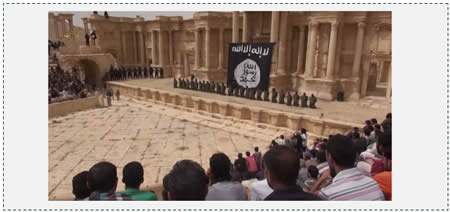
Execution in the ancient city of Palmyra (The Long War Journal, July 5, 2015)
|
The execution of the Syrian prisoners against the background of the antiquities of Palmyra was designed to attract international media coverage, and it indeed achieved its goal. The publication of the video is a characteristic modus operandi of ISIS, which is displaying creativity by frequently inventing new methods of execution. The widespread media coverage of the executions helps ISIS intimidate its opponents and enhance its jihadi image among its supporters. This is not the first time that ISIS has made use of children and adolescents in such executions. |
Southern Syria
Daraa
- According to Syrian sources, the attack by the rebel organizations in Daraa is subsiding and the Syrian Army managed to stop it (Al-Quds Al-Arabi, July 1, 2015). According to reports by Syrian regime sources, 65% of Daraa is in their hands (Syrian TV channel, June 30, 2015). Sources among the rebel organizations said that the attack might be renewed after a reorganization and recruitment of more fighters. According to estimates, about 1,500 operatives from the rebel organizations lost their operational capability and dozens of their tanks, rocket launchers and anti-tank missiles were damaged (As-Safir, July 1, 2015).
Damascus province
- While the battles in the Al-Qalamoun Mountains are waning, the focus has been moved to the area of the city of Al-Zabadani, northwest of Damascus, near the road leading from Baalbek to Damascus (see map). On July 3, 2015, Hezbollah and the Syrian Army launched an attack on the city, most of which is controlled by the Al-Nusra Front and other rebel organizations. There are an estimated 1,500 armed operatives in Al-Zabadani, including ISIS operatives (Al-Mayadeen, July 4, 2015).
- The attack on the city began with an artillery barrage that lasted several days. Then Hezbollah and the Syrian Army attacked the city from several routes. During the first two days of the campaign, Hezbollah and the Syrian Army isolated the city and blocked the supply routes leading to it. The Syrian Air Force also provided air support. At the same time, Hezbollah and the Syrian Army began to attempt to capture the town of Bloudan, east of Al-Zabadani (Al-Mayadeen, July 4, 2015).
|
In the ITIC’s assessment, the attack on Al-Zabadani can be seen as part of the ongoing campaign along the Lebanese-Syrian border, initiated by Hezbollah and the Syrian Army. During the campaign, the focus of the fighting is shifted from area to another. The city of Al-Zabadani once had a population of around 25,000 (as at 2004). It fell into the hands of the Free Syrian Army in January 2012. The Syrian Army regained control of the city, and subsequently the rebel organizations took it over. Al-Zabadani is of great importance because it dominates the main route from Lebanon to Damascus. At least until June 2011, the city served as a logistics hub for the Iranian Revolutionary Guards for supplying arms to Hezbollah (Wikipedia). |
Main developments in Iraq
Al-Anbar province
- According to Iraqi sources, the Iraqi Army, with the assistance of the Iraqi Air Force and the Shiite militias, attacked a number of ISIS positions in the city of Ramadi. Dozens of ISIS operatives were reportedly killed (Twitter, July 4, 2015). On the other hand, ISIS announced on July 5, 2015, that it had carried out an attack on Iraqi Army forces in the area of the Haditha Dam. During the attack, ISIS deployed seven suicide bombers who blew up booby-trapped vehicles (Ana Moslem forum, July 5, 2015).
Al-Baghdadi
- According to a statement posted on July 6, 2015, on an ISIS-affiliated Twitter account, ISIS operatives gained entrance to three buildings used by the Iraqi Army in Ein al-Assad, near the city of Al-Baghdadi, and killed the occupants. They then blew up the buildings (ISIS-affiliated Twitter account, July 6, 2015).
Salah al-Din province
Baiji
- In the city of Baiji, local clashes continue between the Iraqi Army and ISIS, so far inconclusively. The Iraqi Army continues to claim victories in Baiji and has distributed photos of dead ISIS operatives on social networks (Twitter, July 2, 2015). On the other hand, according to a report by ISIS, on July 3, 2015, an Iraqi-born suicide bomber blew himself up among Iraqi Army soldiers south of Baiji, causing heavy losses among the Iraqi troops (Ana Moslem forum, July 3, 2015). According to a report by Iraqi sources on July 5, 2015, two ISIS suicide bombers detonated two car bombs in central Baiji (Reuters, July 5, 2015).
Egypt and the Sinai Peninsula
Combined attack by ISIS’s branch in Sinai against the Egyptian security forces
- On the morning of July 1, 2015, operatives of Ansar Bayt al-Maqdis, ISIS’s Sinai province, launched a combined attack in several locations against the Egyptian security forces in the northern Sinai Peninsula, in an area some 46 km long. The attack was concentrated mainly in the area of the town of Sheikh Zuweid.Operations were also carried out in the area between the Egyptian Rafah and the city of Al-Arish.
- During the attack, car bombs were detonated and, at the same time, around seven checkpoints of the Egyptian security forces were attacked. The attack included a massive light arms fire and anti-tank missiles. In addition,Ansar Bayt al-Maqdis operatives besieged the police station in Sheikh Zuweid and planted explosive charges on the access roads to the town. The assault killed about seventy members of the Egyptian security forces and injured many others (the official Facebook page of the Egyptian armed forces spokesman, July 3, 2015).
- According to Egyptian estimates, the attack was intended to harm the Egyptian security forces, but without taking over any territory, according to the model of Iraq and Syria (although ISIS flags were flown at a number of houses in Sheikh Zuweid during the operation). The combined assault was apparently orchestrated by a senior operative codenamed Kamal Alam. According to the reports, the attacking force was divided into four groups, and each group was given an assignment that included documenting the operation (Al-Youm al-Sabea, al-Shorouk, July 2, 2015).
The version of ISIS’s Sinai province
- On July 3, 2015, two days after the attack, a file-sharing website published an official communiqué on behalf of ISIS’s Sinai province, including full details and photos of what they call Abu Suhaib al-Ansari’s raid.[1]According to the communiqué, more than twenty positions of the Egyptian security forces were attacked (the ITIC considers this figure to be exaggerated),two car bombs were detonated, and there were also suicide bombers who infiltrated into Egyptian outposts. In addition, anti-tank missiles, RPGs, rockets and mortars were used, and the attacking forces blocked roads to prevent the arrival of Egyptian reinforcements (pbs.twimg.com file sharing website, July 3, 2015).
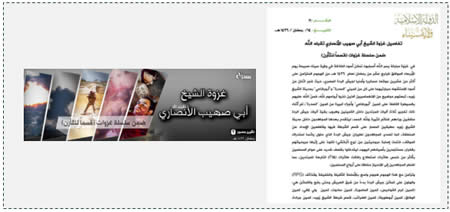
Left: ISIS poster about “Sheikh Abu Suhaib al-Ansari’s raid” (http://nshr.co file sharing website, July 3, 2015). Right: Announcement of the attack in the Sinai Peninsula by ISIS’s Sinai province
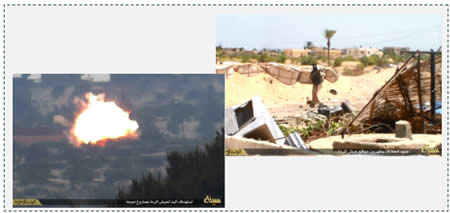
Left: Egyptian Army APC hit by an anti-tank missile fired by ISIS operatives in northern Sinai. Right: ISIS operative firing at a ruined Egyptian position in northern Sinai (http://nshr.co file sharing website, July 3, 2015)
Egypt’s response
- The Egyptian security forces deployed reinforced air and ground troops and commandos against the attacking Ansar Bayt al-Maqdis operatives.Egyptian planes and helicopters attacked targets of ISIS operatives in villages south of Sheikh Zuweid. According to the Egyptians, scores of terrorist operatives were killed. The Egyptians also disconnected communications networks and internet services in order to prevent the terrorist operatives from communicating with one another and activating explosive devices (Al-Youm al-Sabea, July 4, 2015).
- Egyptian armed forces spokesman Mohammad Samir said after the attack that the North Sinai province was under the full control of the Egyptian forces.He said that the ISIS operatives had not taken over the town of Sheikh Zuweid and the city of Al-Arish (Al-Arabiya al-Hadath, July 2, 2015). Egyptian President El-Sisi made a high-profile visit to the northern Sinai Peninsula to examine the deployment of the Egyptian security forces and show his support for them. During his visit, El-Sisi stressed that the situation in the Sinai Peninsula was under control and was completely stable.
Summary
|
The combined attack carried out by ISIS operatives in the Sinai Peninsula against the Egyptian security forces is unprecedented in scope and represents a step up in the activity of ISIS’s branch in Sinai. The branch operatives managed to achieve the element of surprise, carrying out a coordinated attack and causing many casualties among the Egyptian security forces. The attack included a preliminary stage of deploying suicide bombers and detonating car bombs, a modus operandi characteristic of ISIS in its battles in Syria and Iraq. High-level planning and execution capabilities were displayed in this attack. In an interview with Al-Jazeera, Zack Gold, a researcher specializing in the study of Sinai security and relations between Egypt, Israel and the Gaza Strip, pointed out the connection between the operatives of Ansar Bayt al-Maqdis and the operatives in Syria and Iraq, especially in the area of training. According to Gold, there are Bedouins from the Sinai Peninsula who traveled to Syria to join ISIS and, during their stay, were trained in the use of weapons (Al-Jazeera TV, July 2, 2015). |
The Israeli aspect
- On July 3, 2015, two days after the attack against the Egyptian security forces, three 122 mm rockets were launched from the Sinai Peninsula at communities in the western Negev.The rockets fell in an open area in the Eshkol Regional Council. There were no casualties and no damage was caused. ISIS’s Sinai province claimed responsibility for firing three Grad rockets. According to a statement released by ISIS, its operatives launched rockets at Israel in response to Israel’s support of “infidels,” i.e., the Egyptian authorities (ISIS-affiliated forum, July 3, 2015).
- Following the attack on the Egyptian security forces, Israeli security sources reported that Hamas’s military wing in the Gaza Strip was supporting ISIS operatives in the Sinai Peninsula. Israel’s Coordinator of Government Activities in the Territories, Brigadier General Yoav (Poli) Mordechai, mentioned this assistance in an interview with the Al-Jazeera TV on July 2, 2015, the day after the attack on the Egyptian security forces.
- The Israeli coordinator confirms the report (which was published previously) that Hamas in the Gaza Strip is supporting ISIS’s Sinai province, including through the supply of arms and ammunition and the evacuation of casualties from Sinai to hospitals in the Gaza Strip. In this context, the coordinator mentions the name of Wael Faraj, a Hamas battalion commander, who smuggled terrorist operatives from Sinai to the Gaza Strip for medical treatment in the middle of Ramadan. He also mentions the name of Abdullah Qishta, a Hamas operative who trains ISIS operatives in Sinai. The coordinator stresses that he is certain that there is conclusive evidence on this issue (Al-Jazeera TV, July 2, 2015).
ISIS strongly attacks Hamas in the Gaza Strip
- In a video entitled “Message to our People in Jerusalem,” released by the ISIS information office in the Aleppo province, Palestinian operatives from the Gaza Strip threaten Hamas. The video shows a speaker named Abu Qatada al-Maqdisi, who calls Jerusalem “the summit of the fighters’ aspirations”. According to the speaker, what is happening in the Gaza Strip and the Palestinian territories is no secret to anyone. He says thatAllah wants the Gaza Strip to be administered in accordance with the principles of Islamic law [sharia]. The speaker refers to the elimination of the Salafist operative Yunes al-Hanar by Hamas and stresses that ISIS will avenge his death.
- Another speaker named Abu Azzam al-Ghazawi states that the goal of jihad is not to take over one piece of land or another, but rather a war to apply the law of Allah. He notes that Hamas, which claims to be “resistance,” is not teaching its youth to be loyal to the laws of Allah and therefore is not entitled to respect for having launched rockets. Another speaker, named Alama al-Ghazawi, calls on the residents of Gaza to repent and abandon all idols. Otherwise ISIS will be forced to take revenge on them (YouTube, June 30, 2015).
|
Hamas’s aid to ISIS in Sinai, and ISIS’s threats against Hamas in the Gaza Strip reflect Hamas’s dual and contradicting policies: in the Gaza Strip, Hamas suppresses the Salafist-jihadi networks that attempt to challenge its rule and its policy of firing at Israel (including, inter alia, by firing rockets at Israel in contradiction of Hamas’s policy). In contrast, in the Sinai Peninsula, where Hamas and ISIS’s branch have common interests, the Hamas military wing assists Ansar Bayt al-Maqdis, as was reported recently by Israeli sources. |
Israeli Arabs
Bedouin teachers from the Negev disseminated ISIS content at schools
- Israeli security forces recently detained six Bedouin residents of the village of Hura in Israel’s southern Negev Desert. The detainees, from the Abu al-Qiyan clan, were ISIS supporters. Four of them are teachers in the village of Hura and the Bedouin city of Rahat. The six took part in secret meetings on the subject of ISIS’s ideology. Some of them were active in disseminating ISIS’s ideology among family members, friends and acquaintances through online social media. Some of them even considered going abroad to join the fighting in Syria in the ranks of ISIS. The four teachers among the detainees even tried to elicit support for ISIS among students and teachers at the schools where they taught (the ISA website, July 6, 2015; Israeli daily Haaretz, July 7, 2015).
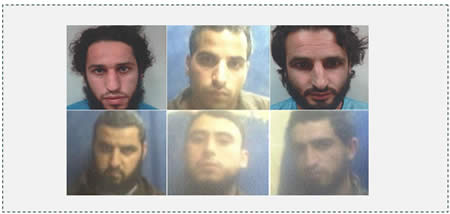
The six Bedouin detainees from the Al-Qiyan clan (ISA, July 6, 2015)
- Previously there have been reports on Israeli Bedouins from the Al-Qiyan clan who joined ISIS and helped arrange the travel of foreign fighters to Syria:
- Othman Abu al-Qiyan, 26, of the Bedouin village of Hura in the southern Negev Desert, set out with his relative Shafiq Abu al-Qiyan to join ISIS. Othman Abu al-Qiyan was killed in Syria in early September 2014 while fighting in the ranks of ISIS. He had studied medicine at Irbid University in Jordan, and completed his internship at Barzilai Medical Center in Ashqelon in May 2014 (Haaretz daily, September 20, 2014). The Israeli media reported that Othman Abu al-Qiyan was the second member of the family killed in Syria. Another Al-Qiyan clan member, a teacher, was also killed in battle in the ranks of ISIS (Israeli website nana10, November 4, 2014).
- Idris Abu al-Qiyan, Othman Abu al-Qiyan’s brother, is a resident of the village of Hura who embraced the Salafist-jihadi ideology. He helped Othman and Shafiq in financing and coordinating their travel to Syria via Turkey. He was charged with conspiring to commit a felony and aiding in an illegal exit [from Israel] (ISA website, November 9, 2014). According to Israeli media, Idris Abu al-Qiyan admitted in his interrogation that he had known in advance about their intention to leave for Syria and assisted them in coordinating their travel via Turkey. He even provided the two men with the money for their travel expenses and gave them details about locals who would be able to help them. From his interrogation, it emerged that most of his contacts with the terrorist elements were made through social networks (Israeli Channel 7, May 27, 2014).
|
The number of Israeli Arabs who joined ISIS and other jihadi organizations has so far been estimated at several dozen (close to 50). Some of them were killed, some returned to Israel and were brought to justice, and others are still fighting in Syria and Iraq. The exposure of the Hura network may indicate that the ISIS ideology has penetrated into the Bedouins in the Negev and into Israeli Arabs. At this stage, however, it is still relatively limited in scope, in comparison with other Western countries. According to the ISA, the overwhelming majority of the Israeli Arab population is strongly opposed to ISIS (ISA, July 6, 2015). |
The global jihad in other countries
Libya
The Derna region
- A jihadi organization hostile to ISIS continues to cleanse the city of Derna of ISIS operatives after ISIS had been removed from it. According to a report from July 1, 2015, the forces of the Shura Council of the Rebels of Derna and its Suburbs broke into houses and positions of ISIS operatives in various regions of the city, confiscated cars and weapons, and threatened to kill and imprison operatives and confiscate their property (Akhbar Libya, July 1, 2015). On July 2, 2015, ISIS operatives attacked the area of the Tobruk Gate in the city (Akhbar Libya, July 2, 2015). A source affiliated with the Libyan army told the media that following the blow suffered by ISIS in Derna during the recent two months, dozens of ISIS operatives fled Libya to Egypt and other countries (Al-Sharq al-Awsat, July 4, 2015).
Counterterrorism and preventive activity
Saudi Arabia
- The Saudi Interior Ministry said three ISIS operatives had been detained after a raid on an apartment in the Al-Sharqiya neighborhood of the city of Taif, west Saudi Arabia. One of the members of the Saudi security forces was killed during the incident, by shots fired from the apartment. In the apartment, the Saudi security personnel found ISIS flags, silencers and computers. An ISIS operative named Yousef Abdullatif Shabab al-Ghamdi managed to escape (Al-Arabiya Channel, July 3, 2015). On July 5, 2015, Saudi authorities announced that Yousef Abdullatif al-Ghamdi had been killed in an exchange of fire with Saudi security forces near his home in Taif (Al-Sharq al-Awsat, July 5, 2015).
- A video was published on July 1, 2015, featuring a Saudi warning of the terror threat inherent in social networks. According to the Saudi, there are over three million songs expressing support for ISIS on various websites and social networks. In addition, he said there were over 1,700,000 videos of ISIS (Al-Arabiya.net, July 1, 2015). According to Saudi interior ministry data, 2,300 Saudis went to Syria to join jihadi organizations. The Saudi security services arrested many suspects related to Syria or Iraq (Al-Hayat, July 7, 2015).
Turkey
- With the continued clashes on the Syrian-Turkish border and the achievements of the Kurdish forces fighting against ISIS, the Turkish Army took precautions along the border. The region was reinforced with soldiers, armored forces and anti-aircraft defense systems (Anatolia, July 1, 2015).
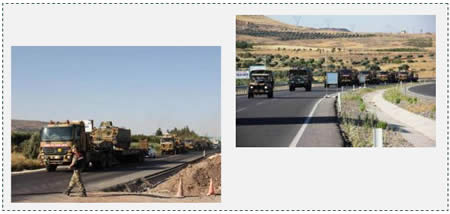
The Turkish Army reinforcing its troops along the border with Syria (PALDF Facebook page, July 2, 2015)
- Turkey’s security forces continue their counterterrorist measures against ISIS operatives: In a combined operation by Turkish police forces at a number of sites in the Izmir area, on the coast of the Aegean Sea, Turkish police detained seven people suspected of affiliation with ISIS. They are suspected of having fought in the ranks of ISIS in Kobani (Ayn al-Arab) and subsequently returning to Turkey. Pistols and shotguns were found in the suspects’ possession (Daily Sabah, July 1, 2015).
- In another operation, 29 people suspected of affiliation with ISIS were detained in the Turkish cities of Ankara, Konya, Izmir, Adana and Gaziantep. They were charged with financial support of ISIS and sending operatives to the organization. During their detention, materials pertaining to ISIS were seized (Zaman, July 1, 2015).
Britain
- British security forces arrested a man who was walking on the streets of London, close to the Houses of Parliament, cloaked with a flag identified with ISIS (with a boy sitting on his shoulders, waving a small flag). The photos were taken by a tourist who uploaded them to a South Korean Internet forum. Policemen spoke with the man, but he was not detained since carrying the ISIS flag is not a crime in Britain (The Independent, July 5, 2015).
Tunisia
- Britain has decided to send fifty members of its Special Forces to Tunisia to assist the Tunisian government in fighting against ISIS-caused terrorism. The decision came following the Tunisian government’s request for assistance from the international community. They will join a list of advisers who arrived in Tunisia from Germany and France, who will help assess the special equipment required by the Tunisian Army. The British contribution will also consist of the installation of a radar station capable of monitoring human movements in vast areas (Express, July 5, 2015). In the last terrorist attack in Sousse, the number of British tourists killed was salient among the fatalities (about 30 out of 38).
[1]Abu Suhaib al-Ansari is the codename of Abu Abdullah Tawfiq al-Freij, co-founder of Ansar Bayt al-Maqdis, who was killed in an accident on March 11, 2014, when an IED in his car exploded (Al-Watan News, July 3, 2015).


















